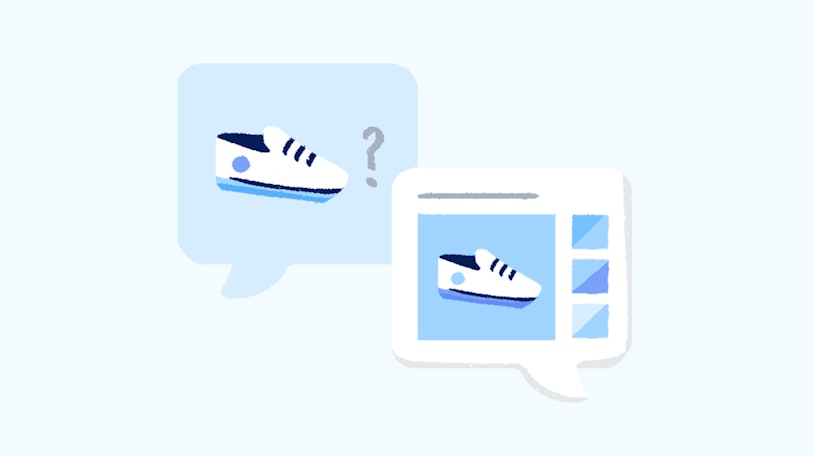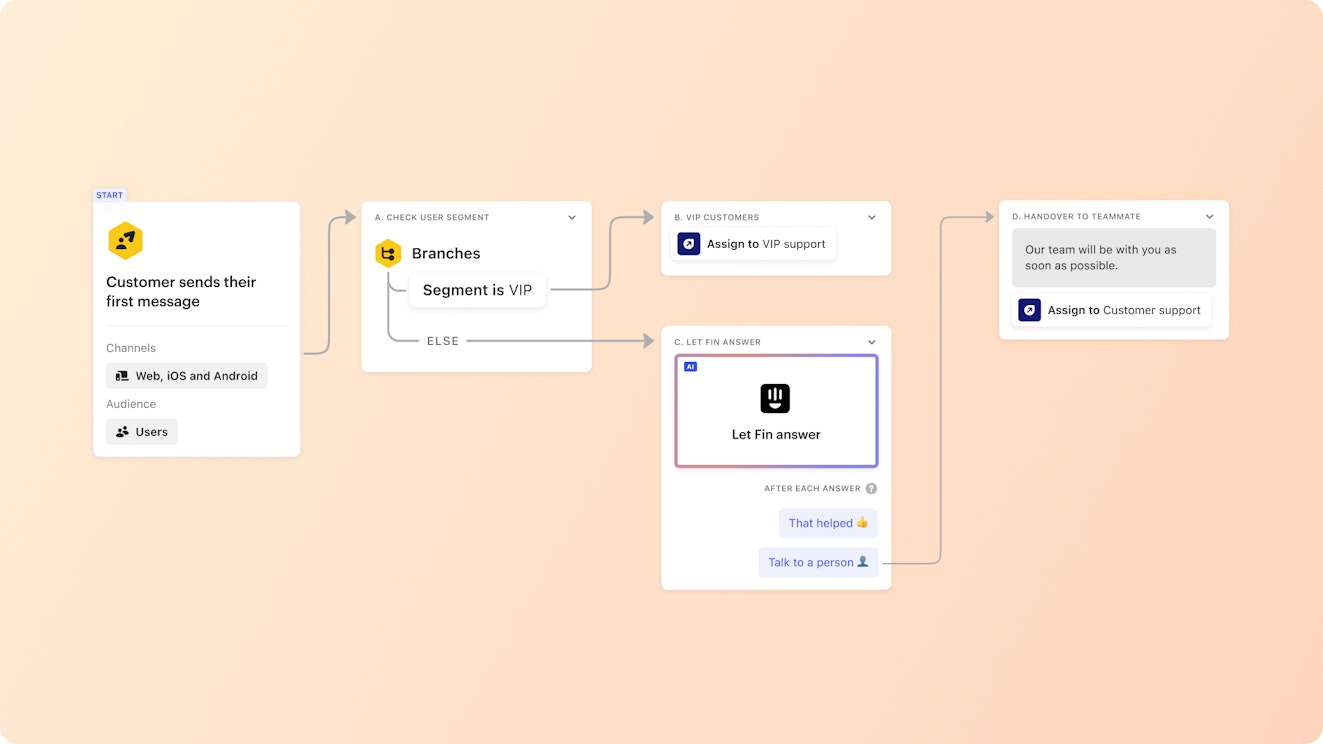Over the last few years, live chat has emerged as one of the fastest growing support channels. There's a good reason for that: It’s quick, convenient, and cost-effective. It’s what the youths call a “triple threat.”
Customer demand for live chat has continuously increased, making it something teams should consider investing in. If you’re new to the live chat landscape, we’ve got you covered.
In this article, we’ll look at what a live chat widget is, how live chat works, what the benefits are, and some options to consider if you’re ready to add live chat to your support stack.
What is a chat widget?
A chat widget is a small pop-up window on your site where a visitor can start a chat interaction with an agent. You can choose which pages on your site you want a chat widget to display, adding to the overall flexibility of the tool.

How does live chat software work?
Though there may be some slight differences between tools, most live chat applications function in the same way.
After embedding the widget on a page, you can choose to set yourself as online, which is when a visitor can start a chat with an agent, or offline, when they won’t be able to start a chat. That said, it’s usually possible for them to submit a support ticket to your team through the widget when you’re offline, which your team can follow up on through email.
From the agent side, when a visitor starts a chat, the agent will generally see a notification of some sort and can choose to start interacting over chat. From there, it plays out much the same as a text conversation would on your phone.
Depending on the tool you use, you can set a limit on the number of chats an agent is able to take at any given time to ensure each customer is getting a great experience. When a chat interaction ends, you generally have a few options:
Close the chat: You both say goodbye and go your separate ways with no further action on either side.
Add a tag or internal note: If your chat tool has analytics capabilities, you might add a tag to keep track of what’s causing visitors to reach out.
Move to another channel: Some issues simply aren’t best handled through chat. In the case something needs more investigation or time to solve, you might move the interaction to a different channel — like email — and follow up from there when you have more information.
Why add live chat support to your website?
Outside of simply being convenient for website visitors, there are three reasons you should consider adding live chat software to your site:
People who interact over live chat are more satisfied. Research shows that people who interact over live chat report higher levels of satisfaction when compared to email, phone, and social media support.
Live chat can help increase conversions. One of the most common reasons someone doesn’t complete a purchase is because they’re not able to get an answer to a question they have. With live chat, you can deliver the answers they need and decrease abandoned carts.
It’s more cost-effective than other real-time support options. Even the best phone support person can only handle one call at a time. With live chat, a highly trained agent can handle several chats at once without sacrificing the level of service.
Features to look for in a chat widget for your website or app
Beyond just facilitating conversations between your business and customers, chat software often comes with specialized features that can make it even more valuable to your team.
A few common chat software features include:
A customizable design: Your web widget and chat box (the interface used by visitors to chat with your team) may be powered by a third-party software, but they’re still an extension of your brand. Any tool you use should make it easy to adjust its appearance to match your brand aesthetic.
Knowledge base integration: The answers to many customer questions can often be found within your knowledge base. Integrating your help center with your chat tool helps surface that information to current and potential customers.
Automation tools: Platforms offer a plethora of features that can help your team work faster and more effectively, like workflows that tag chat conversations, saved replies to easily answer FAQs, and AI features like drafting tools and chatbots to get customers answers more quickly.
Integrations: Linking your chat software with other tools that your team uses can be beneficial. For instance, integrating messaging tools like Facebook Messenger and Instagram with your chat solution might let you handle all of your chats, regardless of platform, all in one place. Connecting an ecommerce platform like Shopify to a chat tool could help you create chatbots that handle tasks like order lookups and returns.
Transcripts: While live conversations are great, it can also be really helpful for both agent and website visitor to have a transcript to go back through if necessary. Look for a chat platform that offers a transcript to both sides of a live conversation once it ends.
Proactive messaging: The option to proactively reach out to a website visitor or customer at a particular moment in the customer journey can be powerful. Some chat tools offer the ability to launch a chat or provide helpful content to visitors based on things like location or browsing behavior.
Mobile accessibility: People spend around half of their internet browsing time using mobile devices like cell phones and tablets. Your chat solution should be optimized for those viewing your site or app on a mobile device. In addition, if your team is frequently away from their desks, you might look for platforms that offer mobile apps for agents as well.
Reporting: Being able to quantify your team’s efforts is a big part of any business strategy. Look for tools that will let you create reporting dashboards that measure things like chat volume, customer satisfaction, and the types of issues resolved.
The 9 best live chat widgets for your business
If you’re convinced chat is something you’re ready to invest in, here’s a list of nine options for you to consider. There is inherently some feature overlap between tools, but each option has some unique traits that make it better suited for certain teams and use cases.
Chat software comparison chart
| Company | Free trial | Price | Features | Best for |
|---|---|---|---|---|
Help Scout | ✅ | Plans start at $20/user per month. |
| Growing teams |
LiveChat | ✅ | Plans start at $20/agent per month. |
| Integrations |
HubSpot Service Hub | Free plan available | Paid plans start at $18/month. Includes two users. Additional users available for $9/ month per user. |
| Existing HubSpot customers |
ChatBot | ✅ | Plans start at $52/month. |
| Automated support |
Brevo (formerly Sendinblue) | ✅ Free plan and trial available | Paid plans start at $15/user per month. |
| Basic chat needs |
Olark | ✅ | Plans start at $29/seat per month. |
| Chat-focused teams |
LiveAgent | ✅ Free plan and trial available | Paid plans start at $9/agent per month. |
| Multilingual support |
Chaport | ✅ Free plan and trial available | Paid plans start at $29/month. Includes 4 agents. |
| Free live chat |
Intercom | ✅ | Plans start at $39/seat per month. |
| Sales and marketing teams |
1. Help Scout
Best live chat widget for growing teams.
Help Scout is a complete customer communication platform that empowers teams to interact with customers across a variety of channels, one of which is live chat. You also get access to a shared inbox, a knowledge base builder called Docs, and proactive messaging tools.
Help Scout’s live chat product is called Beacon and is included on all plan levels. There aren’t any chat limits with Beacon, and anyone who has a seat in your Help Scout account is able to access it. Beacon lets you add a live chat widget to any webpage or within your mobile app.
There are three different modes you can choose from with Beacon:
Ask first: In ask first mode, the widget is set up so customers are prompted right away to ask their question via chat (if someone is available) or over email.
Neutral: In neutral mode, customers see suggested Docs articles, which you can change to fit the page they’re viewing from. They’re also able to search through all your additional Docs content directly through the widget by entering their search term. If they can’t find the answer they need, they can click on the “ask” button at the top of the widget and submit their question directly to your team.
Self-service: Self-service mode is similar to neutral mode, as it displays articles of your choosing and allows customers to search through additional Docs content directly through the widget. The main difference is there isn’t an “ask” button, meaning customers would need to use a different channel to contact your support team.
All chat interactions are saved in a customer’s profile, making them easy to reference in the future if needed. You also get access to chat-specific analytics through Help Scout’s Reporting and AI features to help you keep up with demand and deliver a great chat experience.
Price: Free trial available. Plans start at $20/user per month.
2. LiveChat
Best live chat widget for integrations.
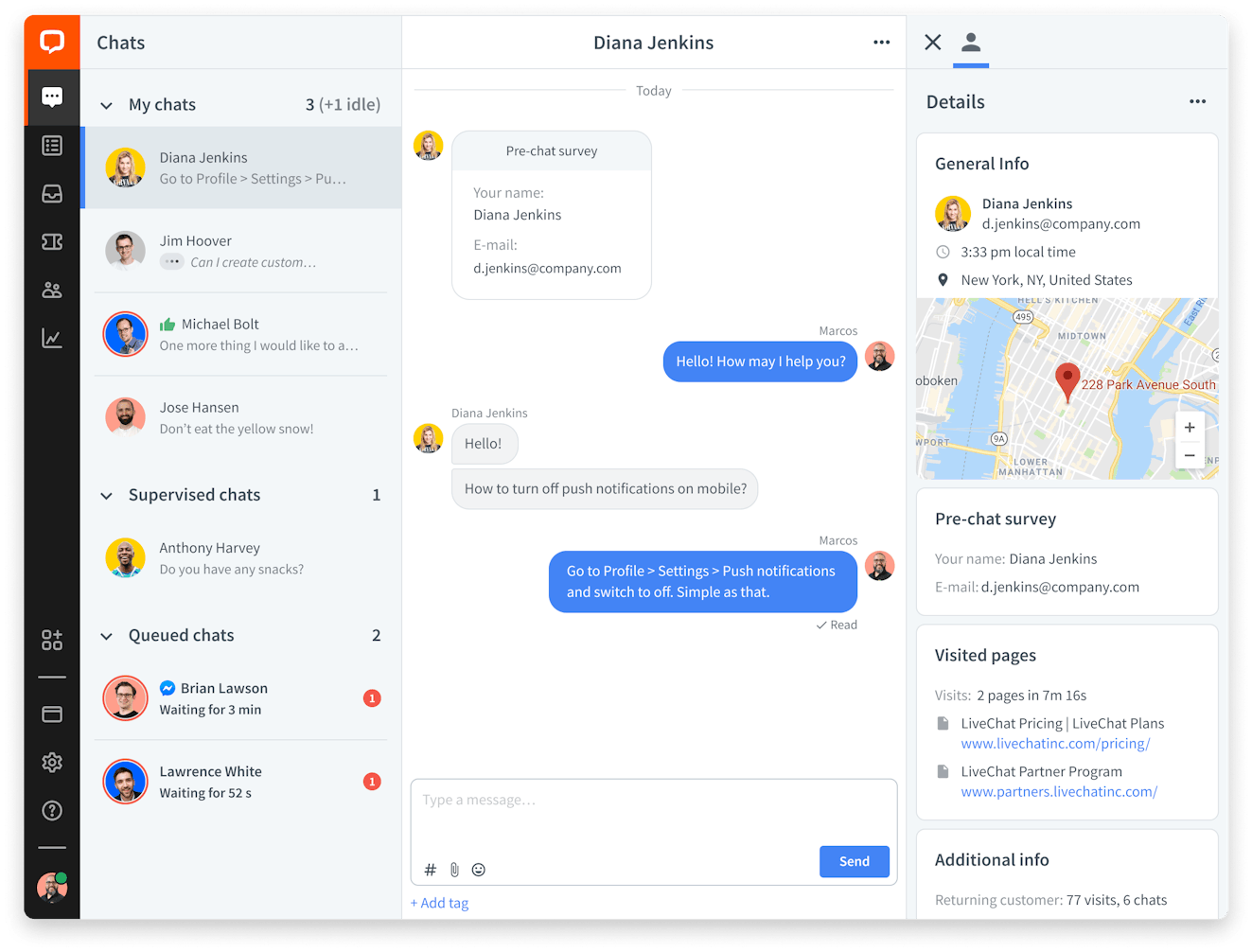
LiveChat is a dedicated chat tool that helps teams deliver a great experience across a number of different chat channels. They accomplish this through an extensive list of over 200 integrations including Shopify, Facebook Messenger, Apple Messages, and many more.
LiveChat has a couple of other standout features like the ability to share product cards directly in the chat widget, making it even simpler for customers to make a purchase. You’re also able to set up basic automations to assign chats to get customers the best support quickly.
Other useful live chat features include canned responses, the ability to organize chats by tags, and easy transfer of chats between agents. For those interested in chatbots, check out ChatBot a little further down the list. Both LiveChat and ChatBot are part of the Text suite of support applications.
Price: Free trial available. Plans start at $20/agent per month.
3. HubSpot Service Hub
Best live chat widget for teams using another HubSpot product.
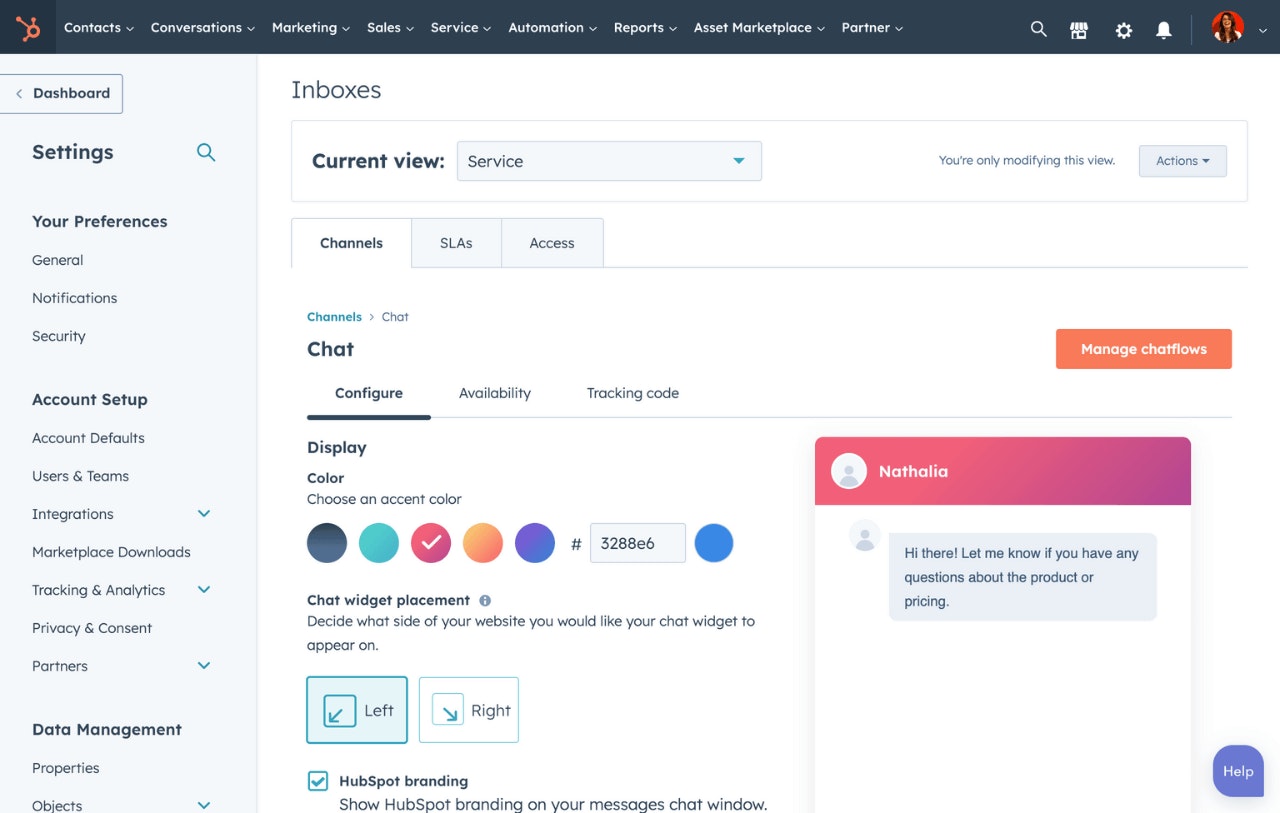
When most people think of HubSpot, they think of their sales and marketing tools like their CRM. Over the past few years, they’ve developed a customer service software offering called Service Hub. Service Hub includes a number of different service tools, including chat.
When a customer starts a chat, agents see a notification in a universal inbox, making those interactions easy to manage. You can also set office hours to let customers know when a live agent is available and even automate routine support interactions by building a basic chatbot.
Last, but certainly not least, if you use HubSpot CRM you’re able to see customer profiles and previous conversation history to have more context when handling customer requests.
Price: Free plan available. Paid plans start at $18/month (includes two users).
4. ChatBot
Best live chat widget for automated support.
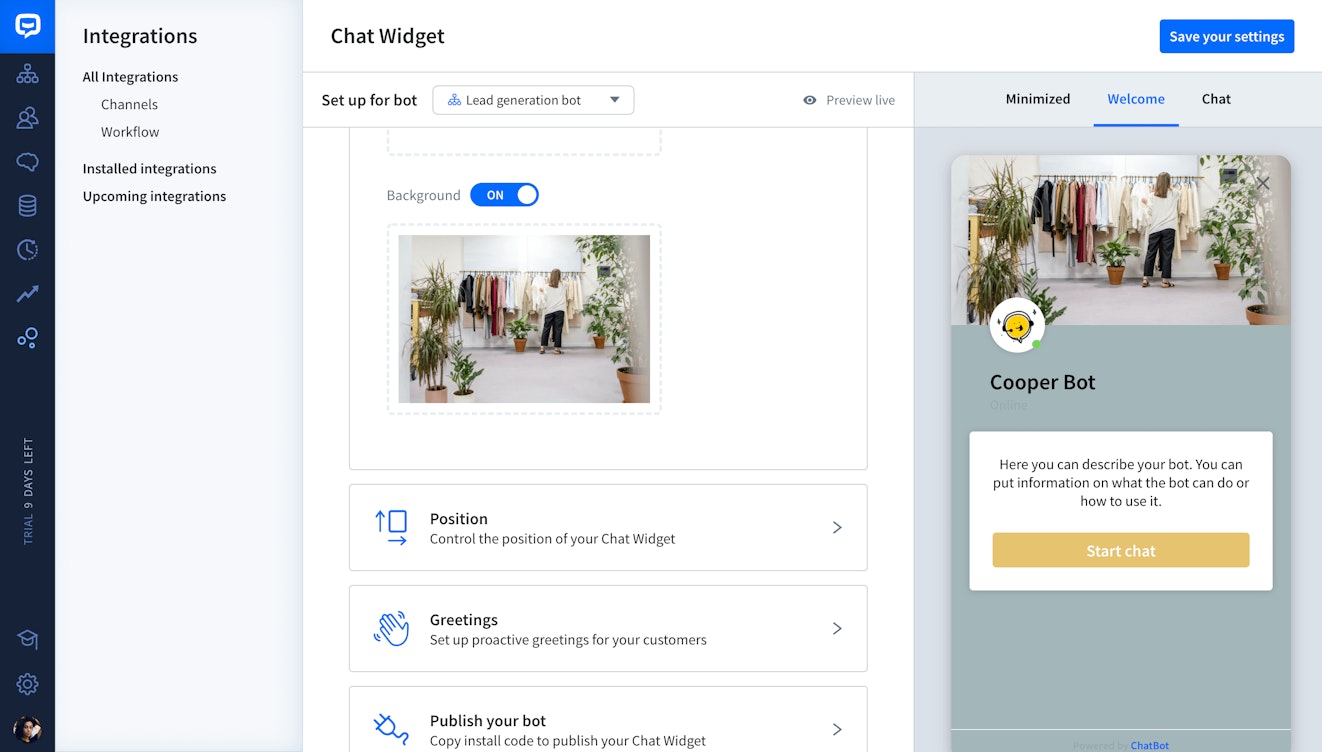
Though most of our list is focused on tools that help agents provide live chat support, another great use for a chat widget is offering automated support through chatbots. The aptly named ChatBot is one of the best options on the market.
ChatBot’s no-code software makes creating chatbots a breeze. Through their ChatBot academy, you’re able to learn the ins and outs of the product. If you want to get going even faster, there’s also a large library of prebuilt bots to choose from.
Much like every tool on the market these days, ChatBot also offers the option to use AI to make your bots even smarter. Train them on your website, knowledge base, or data from your help desk to help your customers get answers fast.
Price: Free trial available. Plans start at $52/month.
5. Brevo (formerly Sendinblue)
Best live chat widget for basic chat needs.
Brevo is a platform that is mainly focused on marketing and sales tools. Their tool, Conversations, helps teams engage with customers across several channels, including live chat, Facebook, Instagram, WhatsApp, offline messaging, phone, and email.
The platform has a lot of the same features you will find included with most chat software, such as saved replies, chat notes, and usage analytics. It also has some more specialized abilities like being able to see what is in a customer’s cart as well as a feature that lets you see what a customer is typing before they hit send.
Like with other tools, Brevo offers a couple of chatbot options. One collects lead information using a form directly from your site, the other is a chatbot that can be programmed to respond to customer FAQs.
Price: Free trial and plan available. Paid plans start at $15/user per month.
6. Olark
Best live chat widget for chat-focused teams.
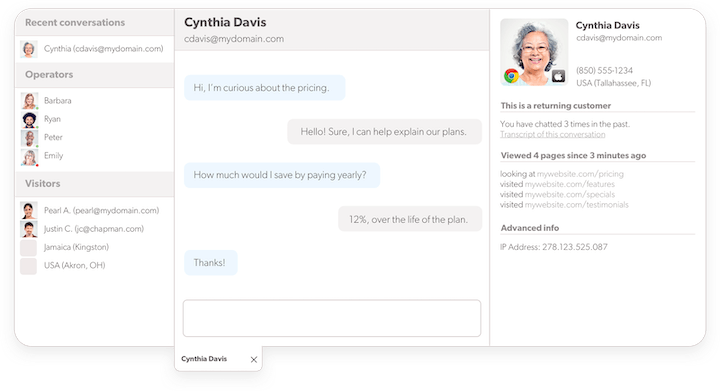
Olark is a dedicated chat tool that empowers teams to deliver live chat support as well as automated chat support through chatbots. Olark also includes a number of productivity features like canned responses to answer frequently asked questions quickly and chat routing to automatically assign new chats.
When you sign up, you also get access to team and agent-level analytics to better understand overall trends and individual contributions. In addition, Olark offers a number of native integrations with tools like Slack and MailChimp.
Price: Free trial available. Plans start at $29/seat per month.
7. LiveAgent
Best live chat widget for multilingual support.
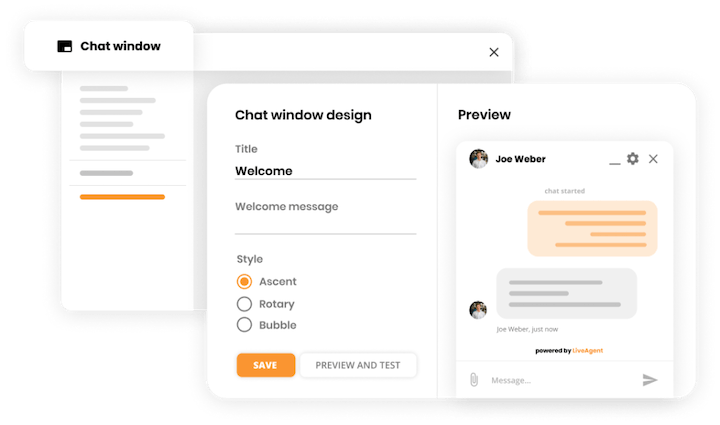
When LiveAgent first started, they were focused on live chat. Over the years they’ve added more tools like a shared inbox and a knowledge base builder, but they still have a very robust chat tool. Some key features LiveAgent offers are chat-specific analytics, pre-chat forms to offer agents more context for conversations, and a real-time typing view to let you see what someone is typing before they hit send, helping you deliver great service that much faster.
LiveAgent is also optimized for multilingual support. The software currently supports 43 different languages, allowing you to customize your chat widgets to display whichever language your customers prefer. In addition, you can use the system to route customers to agents who speak their language.
Price: Free trial and plan available. Paid plans start at $9/agent per month.
8. Chaport
Best free live chat software.
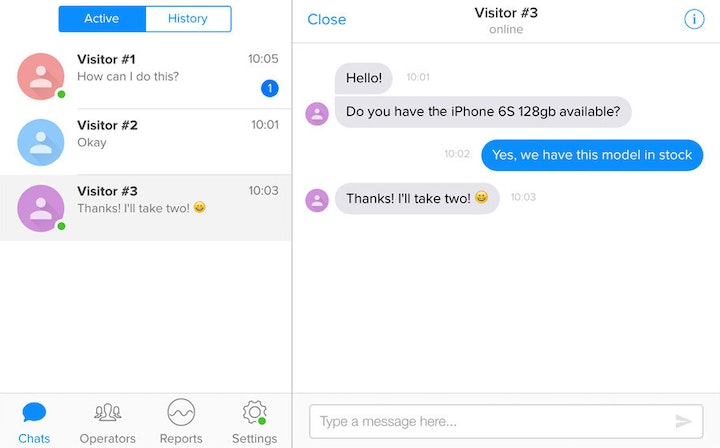
Chaport is a customer support tool that offers solutions for live and self-service support. With Chaport you’re able to add a live chat widget to your site as well as build out chatbots for automated support. You’re also able to connect to a number of messaging apps like Facebook Messenger and Viber to keep all your chat interactions in one place.
Chaport also offers knowledge base building software, which you can connect to your chat widget to suggest articles to customers to deliver quick support while reducing requests for your live staff. Other notable features include saved replies, typing insights, a multilingual chat widget, and reporting dashboards.
Price: Free trial and plan available. Paid plans start at $29/month (includes four agents).
9. Intercom
Best live chat widget for sales and marketing teams.
Intercom is all about engaging with customers. The product focuses on a powerful web widget called Messenger. Installing the widget on your website or within your app opens up a number of communication paths between a company and its customers. Through Messenger, you can chat with customers live or asynchronously. The widget also offers access to knowledge base articles as well as any content like blog posts or announcements that you want to surface to your visitors.
Looking at Intercom’s features, it’s clear they have a higher focus on using chat for marketing and sales. For example, you’re able to set up push notifications and A/B test copy for pop-up messages. It also has a lot of non-chat features that appeal to marketing and sales teams like product tours and tooltips. Though many product features are more focused on other business functions, the platform has aimed to focus more on support over the last couple of years. The software also has some support-focused features like team inboxes and ticketing features.
Also worth discussing is Intercom’s AI-powered chatbot offering, Fin. It can answer FAQs based on support content, author bespoke responses based on external data like order history or billing data, and target its answers based on customer data like location or customer personas. Fin is not included with any plan; instead, it utilizes a usage-based model, with each resolution costing $0.99.
Price: Free trial available. Plans start at $39/seat per month.
How to install a website chat widget
Though the procedure may vary from tool to tool, installing a chat widget on your website is fairly simple. To give you an idea of how it works, here is how you set up a Beacon in Help Scout:
1. Within Help Scout, head to the Manage menu, then select Beacons. Customers who have never created a Beacon before will see the following page. Click Create a Beacon.
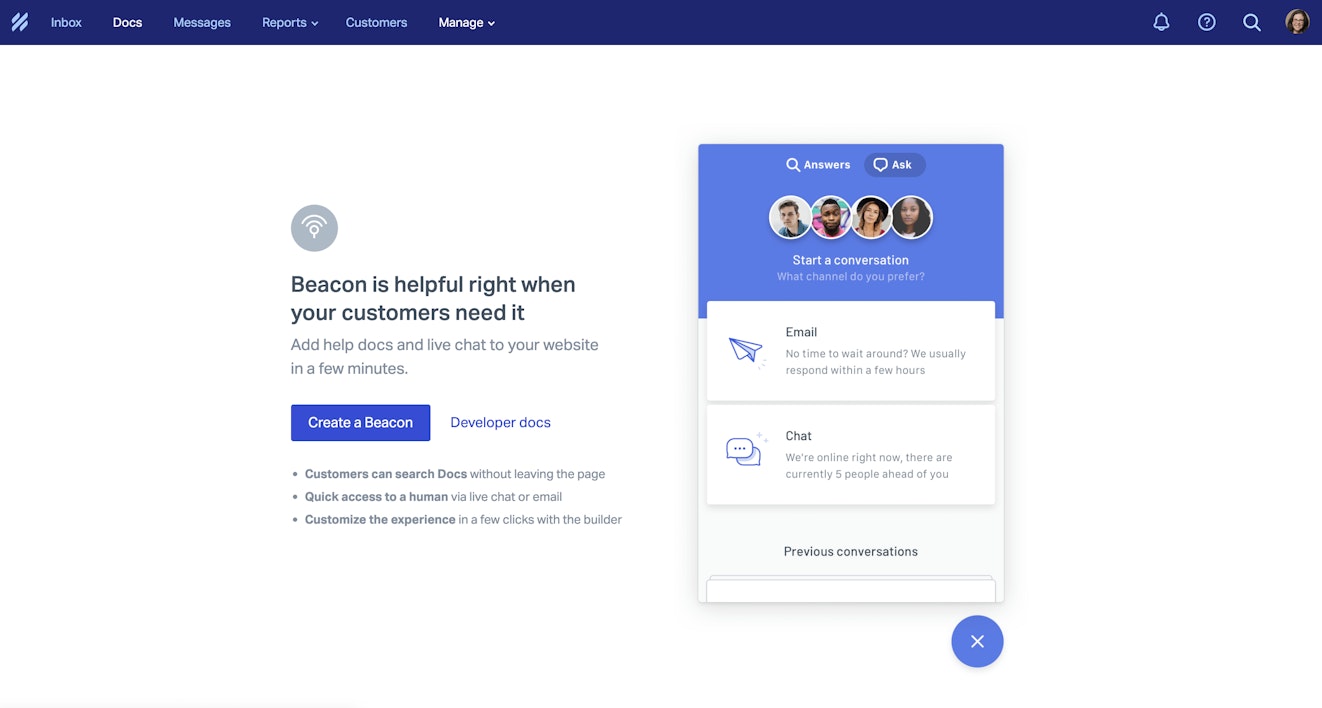
2. Customize your Beacon by changing its name, color, button style, etc.
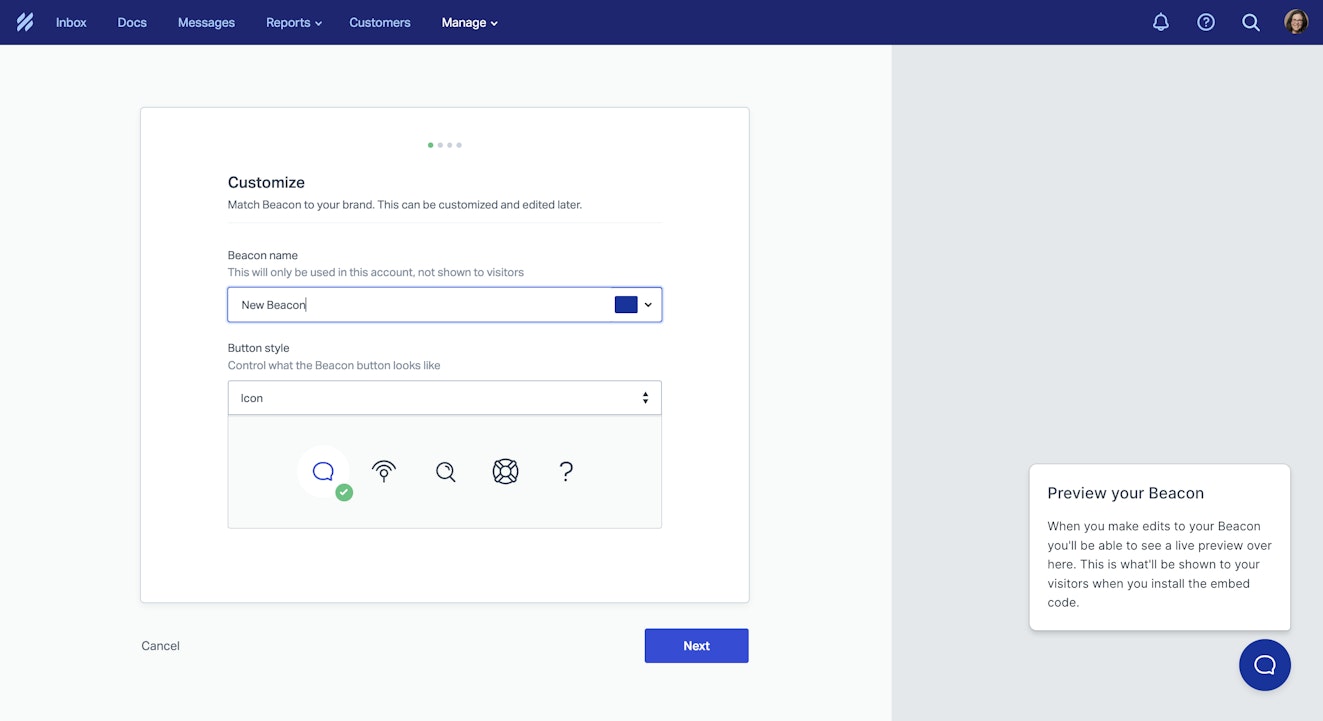
3. Decide how customers will be able to contact you via the Beacon.
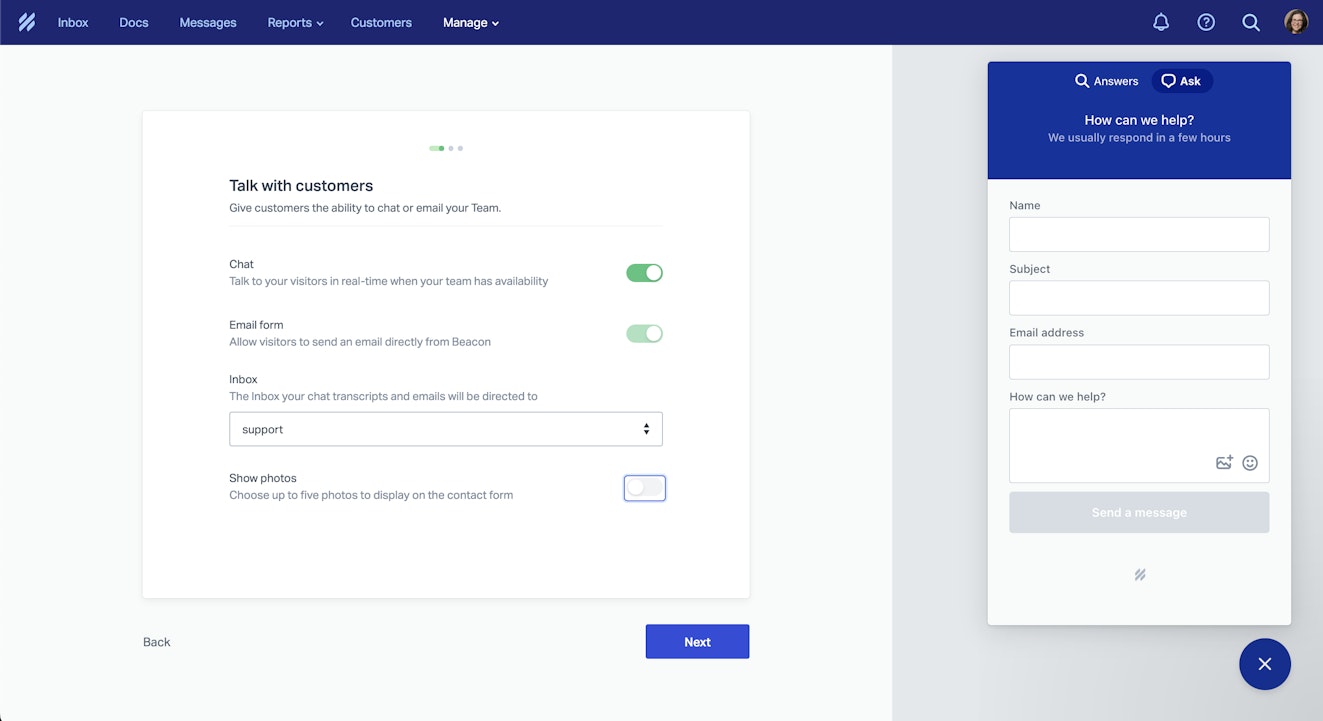
4. Choose your contact and self-service settings.
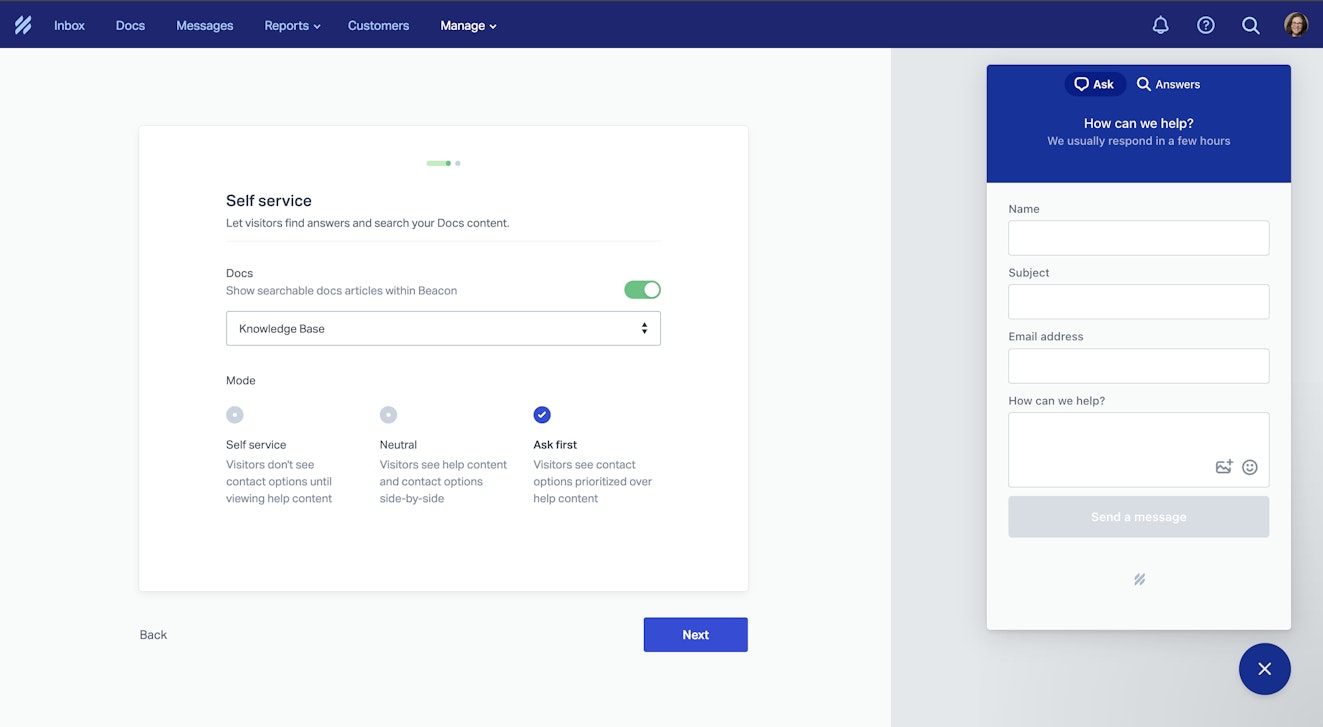
5. Copy the installation code and paste it into your site’s source code before the </body> tag.
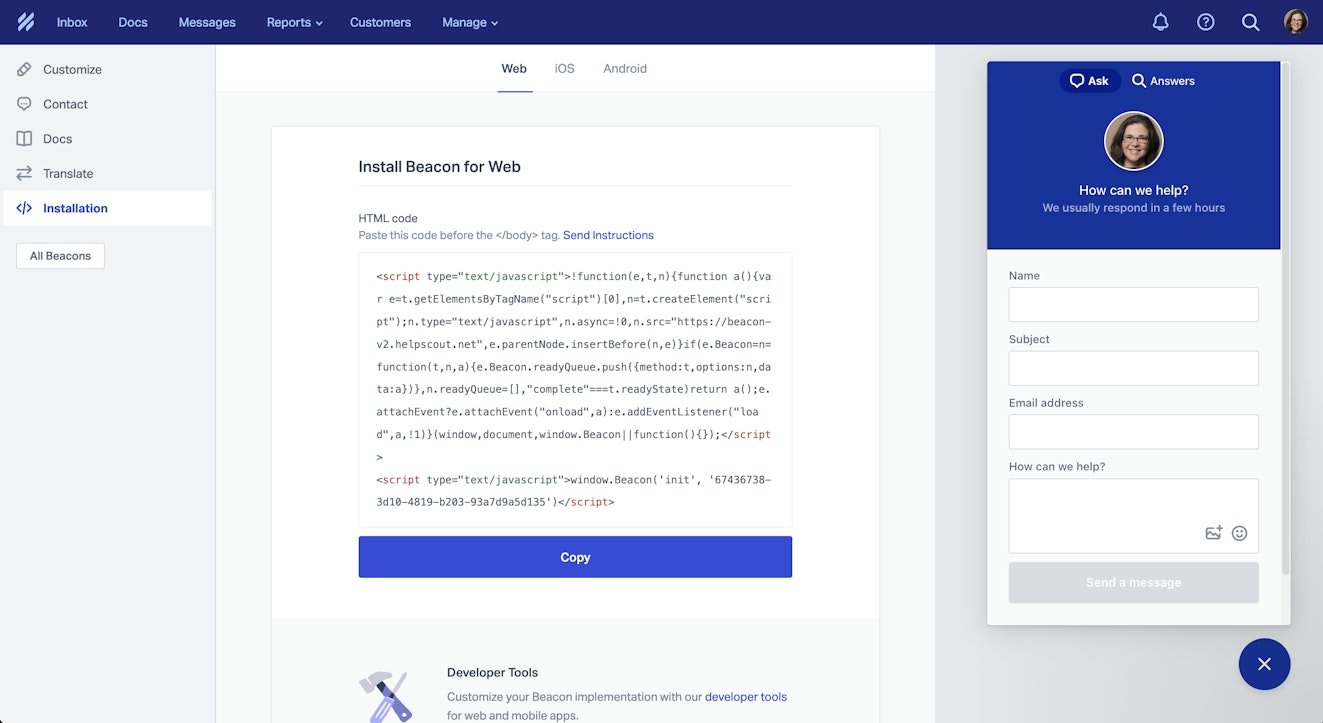
If you need to send instructions to your IT team, click the Send Instructions link as seen on the screen above. Additional information for adding a Beacon to your site can be found in this Docs article.
Improve customer communication with chat
Adding a chat widget to your app or website can be a great addition to your support strategy. It helps customers easily connect with your team as well as creates an avenue for you to provide proactive assistance.
Picking the right live chat tool comes down to what your specific needs are. Once you have a good idea of how you’ll use the tool, take the time to test out a couple of options. Having that firsthand experience can help making a decision easier if two tools are equal on paper.
You should also check out their training resources and consider sending a ticket to their support team. Even the most tech-savvy users need help from time to time, so knowing what level of support you’ll have is always good. If you still want a little more guidance in the process, check out our Buyer’s Guide to Choosing the Right Customer Support Tool.



